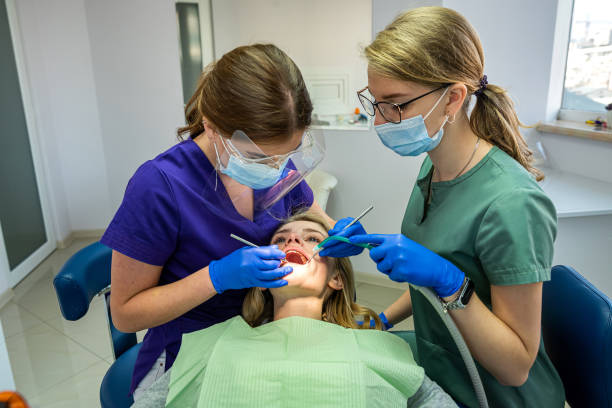The two terms ‘Orthodontic Assistant’ and ‘Dental Assistant’ seem alike. But ever wondered what’s the difference between the two? If yes, then this article is for you. Here, you’ll know everything about the two in detail.
Who Is An Orthodontic Assistant?
Orthodontic assistants play a crucial role in the field of dentistry, specializing in orthodontics. Their primary focus is on straightening teeth and correcting jaw alignment or bite issues.
They work alongside orthodontists to help patients achieve healthier and more aesthetically pleasing smiles.
Duties of an Orthodontic Assistant:
Orthodontic assistants have a range of responsibilities, including:
- Assisting orthodontists in assessing a patient’s teeth and developing a treatment plan for straightening them.
- Performing routine orthodontic procedures, such as cleaning teeth and making adjustments to orthodontic devices like braces.
- Ensuring the cleanliness and sterilization of instruments, equipment, and work areas.
- Preparing tools for orthodontists and passing them instruments during procedures.
- Taking X-rays, photographs, casts, molds, and impressions of patients’ mouths to aid in diagnosis and treatment monitoring.
- Providing support to orthodontists during dental emergencies.
- Greeting and checking-in patients, addressing their dental concerns, and answering their questions.
- Handling clerical tasks, such as organizing and updating patient records, processing payments, and scheduling appointments.
The Purpose of Orthodontic Treatment:
The primary purpose of orthodontic treatment is to correct the misalignment of teeth and jaws.
Misaligned teeth or an improper bite can lead to various issues, including difficulty chewing, discomfort, sleep apnea, and an increased risk of gum disease.
Additionally, orthodontic assistants may also provide cosmetic services for patients who desire a straighter and more attractive smile.

Tools Used by Orthodontic Assistants:
Orthodontic assistants use a variety of specialized tools and equipment, including:
- Braces: These devices consist of brackets and wires and are used to straighten teeth.
- Retainers: Retainers help maintain the results achieved through orthodontic treatment.
- UV curing lights: These lights are used to set or cure orthodontic adhesives.
- Dental instruments: for adjustments and maintenance.
- X-ray machines and imaging equipment: for diagnostic purposes.
Education and Training Requirements for Orthodontic Assistants:
To pursue a career as an orthodontic assistant, individuals typically need:
- A high school diploma or GED equivalent.
- CPR certification, which is often a prerequisite for healthcare-related roles.
- Specialized training in orthodontic assisting.
- Some orthodontic assistants choose to complete a two-year associate degree in dental assisting.
- Training programs specific to orthodontic assisting are available and provide hands-on experience.
Orthodontic Assistant Salary:
The salary of an orthodontic assistant can vary based on factors such as geographical location, years of experience, and the specific dental practice. On average, orthodontic assistants earn approximately $43,897 per year nationally. However, salaries may be lower or higher depending on the region and the demand for orthodontic services in that area.
What is a Dental Assistant?
A Dental Assistant is a professional who collaborates with a dentist in a particular dental clinic.
The role of a dental assistant is a very crucial one in the efficient functioning of the dental practice. They provide their valuable feedback and support to the dentist, whilst also ensuring that the patients are at ease and receive proper care.
Duties of a Dental Assistant:
Dental assistants work closely with dentists to maintain the oral health of patients. Their responsibilities include:
- Cleaning and sterilizing dental tools and work areas in the dental office and examination rooms.
- Assisting dentists during examinations and dental procedures by passing instruments.
- Using suction hose tools to keep patients’ mouths dry and comfortable during treatments.
- Aiding in oral surgery procedures, such as applying topical anesthetics, suturing gums, and removing stitches.
- Communicating with patients to create a welcoming environment, ease anxiety, and answer their questions.
- Providing discharge instructions and educating patients on proper oral health and hygiene.
- Treating tooth decay, removing cavities, repairing chipped teeth, and creating mouthguards for teeth grinding.
- Performing clerical tasks like answering phones, scheduling appointments, and preparing patients for the dentist’s arrival.
Purpose of Dental Treatment:
The primary purpose of dental treatment is to maintain and improve the health and functionality of teeth and gums. Dental assistants play a crucial role in preventing and treating gum infections and diseases, including gingivitis and periodontitis. They also address issues like tooth decay, cavities, and other dental problems.

Tools Used by Dental Assistants:
Dental assistants use various tools and instruments, including:
- Dental drills for procedures such as cavity preparation.
- Excavators for removing decayed tooth material.
- Mouth mirrors to provide dentists with a clear view of the patient’s oral cavity.
- Sickle probes for detecting dental issues.
- Instruments for tooth extractions, sutures, and other oral surgeries.
Education and Training Requirements for Dental Assistants:
To become a dental assistant, individuals typically need:
- A high school diploma or GED equivalent.
- CPR certification, similar to orthodontic assistants.
- Completion of accredited programs or courses in dental assisting.
- Certification options include National Entry Level Dental Assistant, Certified Dental Assistant, and others offered by the Dental Assisting National Board (DANB).
Dental Assistant Salary:
Dental assistant salaries can vary depending on factors such as location, experience, and the complexity of the procedures they are involved in.
On average, dental assistants earn approximately $60,464 per year nationally. The demand for dental assistants may be higher than for orthodontic assistants due to the broader scope of dental services provided.
Orthodontic Assistant vs. Dental Assistant
In this section, we will explore the key differences between orthodontic assistants and dental assistants.
Duties:
While both orthodontic and dental assistants are essential in dental care, their duties differ significantly based on the focus of their medical care.
Orthodontic assistants are primarily involved in assessing, maintaining, and adjusting orthodontic devices like braces and retainers, with a focus on teeth alignment.
Dental assistants, on the other hand, primarily concentrate on cleaning teeth and gums, providing treatments, and assisting with various dental procedures.
Purpose:
The purposes of these two professions also vary. Dental assistants focus on maintaining the health and functionality of teeth and gums, ensuring they are free of diseases and issues.
They may also perform procedures to enhance the aesthetics of teeth. In contrast, orthodontic assistants primarily work on the structural aspects of teeth and jaws, correcting their positions to improve functionality and appearance.
Procedures:
Orthodontic assistants assist or perform procedures like X-rays, banding, bonding, archwires, impressions, and photographs.
These procedures are specific to the field of orthodontics and are aimed at straightening teeth and aligning jaws.
Dental assistants, on the other hand, are involved in different procedures such as bonding, crowns, bridges, fillings, tooth extractions, and sutures, which encompass a broader range of dental care.
Tools:
While both types of assistants may use some common instruments such as cheek retractors and bite sticks, dental assistants are more likely to work with dental drills, excavators, and mouth mirrors.
Orthodontic assistants are specialists in tools related to braces, retainers, and UV curing lights.
Career Path:
The career paths of dental and orthodontic assistants may differ based on individual interests and career goals. Dental assistants often have the opportunity to advance to become dental hygienists, dentists, or even pursue careers in nursing or medicine.
They can also transition to administrative roles within dental offices. In contrast, orthodontic assistants may choose to become full-time orthodontists or continue their work as specialized assistants.
Salary:
Salaries for orthodontic and dental assistants can vary widely based on factors like location, years of experience, and the complexity of procedures performed.
According to Indeed Salaries, the national average salary for an orthodontic assistant is approximately $43,897 per year, while the national average salary for a dental assistant is higher, at $60,464 per year.
The difference in salaries can be attributed to the demand for dental care throughout one’s lifetime, as well as the broader range of services provided by dental assistants.
Choosing the Career Path
Choosing between a career as an orthodontic assistant or a dental assistant is an important decision that depends on individual preferences and career aspirations. Both paths offer valuable opportunities in the field of healthcare, and here are some factors to consider when making your choice:
- Interest and Passion: Consider your personal interests and passion for dental care. If you are particularly intrigued by the structural aspects of teeth and jaws and enjoy working with orthodontic devices, becoming an orthodontic assistant may be a better fit.
On the other hand, if you have a broader interest in general dental care, dental assisting could be more appealing. - Patient Interaction: Think about the level of patient interaction you desire. Orthodontic assistants often see patients regularly, typically every six to eight weeks, as they monitor progress with braces. Dental assistants may build long-term relationships with patients and their families, seeing them every six months for routine check-ups.
- Career Growth: Consider your long-term career goals. Dental assistants have the opportunity to advance into various healthcare roles, including dental hygienists, dentists, or administrative positions. Orthodontic assistants can choose to become orthodontists or continue their specialized work.
- Salary and Demand: Research the salary potential and demand for each profession in your desired location. Factors such as geographical region and the specific dental practices in the area can influence both salary and job availability.
- Education and Training: Assess the education and training requirements for each path and determine which aligns better with your educational background and goals.
Why Choose Illinois Health Careers?
Illinois Health Careers is your gateway to a successful healthcare career. Whether you’re considering a career as an orthodontic assistant, dental assistant, or any other healthcare profession, our institution is dedicated to equipping you with the knowledge and skills needed for success.
We believe that healthcare education should be accessible, innovative, and focused on practical experience. Choose Illinois Health Careers for your journey toward a rewarding healthcare profession in Illinois.


